Essential Guide to Summer Wetsuits for Kiteboarders
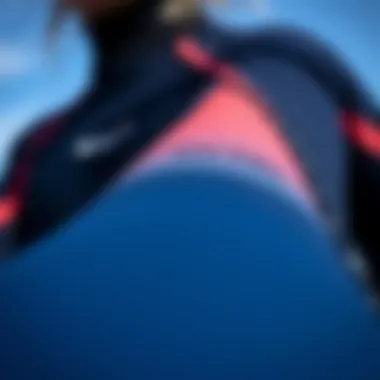
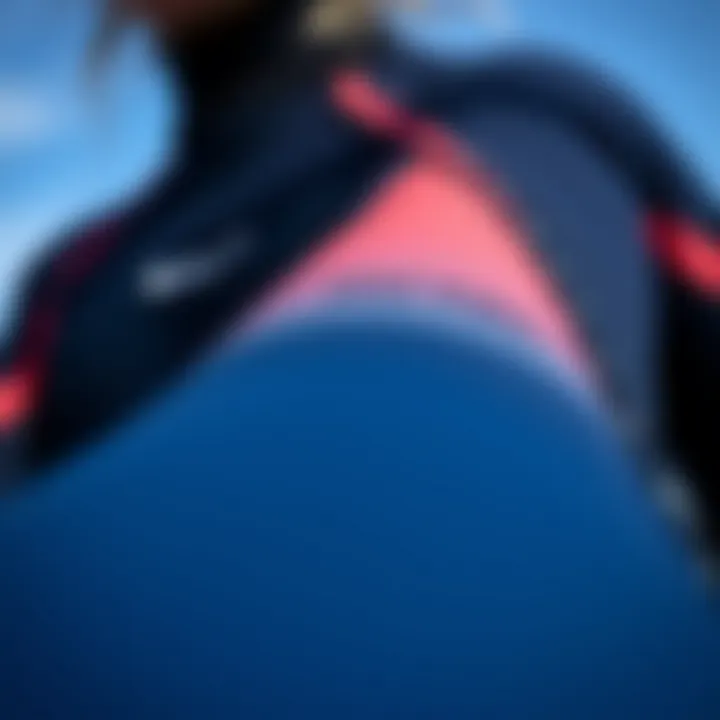
Intro
Kiteboarding during the summer can be an exhilarating experience, especially given the warm winds and vibrant waters that call out to enthusiasts. However, one essential piece of gear often overlooked or misunderstood is the summer wetsuit. While you might be tempted to jump right into action, the right wetsuit can enhance your performance and enjoyment in ways you might not expect.
This article unfolds the vital aspects of summer wetsuits tailored for kiteboarders, shedding light on everything from materials to fit. Understanding these elements can elevate your days spent on the water, transforming a good session into a great one. Whether you’re a seasoned pro or just starting, making informed choices about your wetsuit is paramount to your kiteboarding journey.
With that in mind, let’s dive deep into the nitty-gritty of how to select the gear best suited for summer kiteboarding. We’ll explore the types of wetsuits available, how to ensure proper fit, and much more.
Gear Selection
When it comes to kiteboarding, choosing your gear wisely impacts everything from your comfort level to performance. A well-fitted wetsuit not only shields you from cold water but also lets you move freely, making it essential to find one that fits like a glove.
"A wrong fit can turn the thrill of riding into a struggle, rather quickly."
Types of Wetsuits
In the realm of summer wetsuits, you generally have three main types:
- Shorty Wetsuits: As their name suggests, these suits feature short sleeves and short legs, offering maximum flexibility while keeping your core warm. They are ideal for warm water conditions where you still need a bit of protection.
- Long-Sleeve Wetsuits: This type covers the arms while maintaining shorter legs. They’re a great compromise for those who experience slightly cooler waters yet prefer a wider range of motion than traditional full suits allow.
- Full Wetsuits: While these might not be as common for summer use, they can be beneficial if you’re in an area where water temps fluctuate unexpectedly. Compression, insulation, and buoyancy come as a plus with this option.
Selecting the type of wetsuit depends not just on personal preference but environmental factors like water temperature and your sensitivity to cold.
Choosing the Right Fit
Fitting a wetsuit properly is like finding the right key to a lock – it should feel snug but not restrictive. Here are some things to watch out for when trying on your wetsuit:
- Seam Placement: Ensure seams sit flat against your skin, avoiding any bunching that could chafe.
- Jetting Temperature: A well-fitted wetsuit should create a seal around your ankles, wrists, and neck to keep water from flushing through.
- Mobility: Lift your arms and twist your torso. You should feel unrestricted in your movements.
- Size Matters: Each brand has different sizing charts; don’t hesitate to try on several sizes or even get recommendations to find your best fit.
Remember, a well-fitted wetsuit not only keeps you warm but also enhances your control over the board, enabling smoother movements.
As summer heats up, understanding these key elements will ensure your kiteboarding experience goes swimmingly. It’s not just about looking good in the water, it’s about feeling good too – and your summer wetsuit is crucial to that equation.
In the following sections, we will further dissect skill development in kiteboarding, focusing on techniques that enhance your prowess in the sport.
Preamble to Summer Wetsuits
For kiteboarders, the right summer wetsuit can make the difference between a satisfying session and one that ends in discomfort. During the warm months, kiteboarding enthusiasts face the challenge of balancing comfort and protection. The sun shines brightly, and while the water may feel inviting, it can still be chilly, especially during high-speed descents or unexpected tumbles. A summer wetsuit becomes an essential piece of gear, providing both warmth and freedom of movement.
Defining Summer Wetsuits
Summer wetsuits are typically thinner than their winter counterparts, often made from materials like neoprene that are designed to insulate while allowing for mobility. Often ranging in thickness from 2mm to 3mm, these suits are tailored to keep you cozy without overheating. Unlike heavier wetsuits, summer variants offer a considerable range of motion to accommodate the bold maneuvers kiteboarders frequently execute.
- Materials: The primary construction happens with various types of neoprene, which is flexible and provides warmth.
- Design: Many summer wetsuits come in shorty styles or full suits, depending on the level of coverage desired.
These suits are engineered not just for warmth but also for ease of wear. For kiteboarders, the right fit is critical, allowing for a snug but comfortable feel that avoids restricting movement. Over time, kiteboarding has adapted, leading to specialized designs that blend comfort, durability, and performance.
Why Choose a Summer Wetsuit?
Choosing a summer wetsuit does not merely hinge on personal preference, but it also relates to performance and safety. The right wetsuit:
- Provides Thermal Protection: Even in summer, water temperatures can drop significantly. A wetsuit retains body heat, preventing hypothermia in cooler conditions, especially when you're splashed.
- Enhances Performance: A well-fitted suit allows for maximum agility, crucial when maneuvering your board and harnessing the wind. An unfitting suit can act as a hindrance.
- Offers UV Protection: Extended exposure to the sun can lead to skin damage. Most summer wetsuits provide a barrier against harmful rays.
- Reduces Friction: The suit can serve to protect against chafing and irritation caused by the harness and board edges against the skin, allowing for longer, more enjoyable sessions.
In sum, a summer wetsuit is not just about staying warm—it's about enhancing your overall kiteboarding experience. Choosing the right wetsuit means understanding your local conditions, personal preferences, and the activities you plan to undertake, ensuring each ride is both enjoyable and fulfilling.
"For kiteboarders, the right summer wetsuit adapts to their body, the wind, and the waves, ensuring that each moment on the water is as exhilarating as the next."
Choosing the right summer wetsuit involves a careful blend of technology, personal comfort, and awareness of the conditions you’ll be navigating. As we dive deeper, we will explore the materials used in summer wetsuits and the essential design considerations that cater specifically to the needs of kiteboarding enthusiasts.
Materials Used in Summer Wetsuits
When discussing summer wetsuits tailored for kiteboarders, the emphasis on materials cannot be overstated. The right fabric plays a pivotal role not just in providing protection from the elements but also in enhancing performance and comfort while on the water. A solid understanding of these materials allows kiteboarders to make informed choices based on their unique needs and preferences.
Neoprene Variants
Neoprene remains the backbone of wetsuit manufacturing, especially in warmer conditions. This synthetic rubber comes in variances that are particularly suited for summer wear. For instance, closed-cell neoprene is well-known for its buoyancy and thermal retention qualities, making it a popular choice for kiteboarders looking to strike a balance between warmth and mobility.
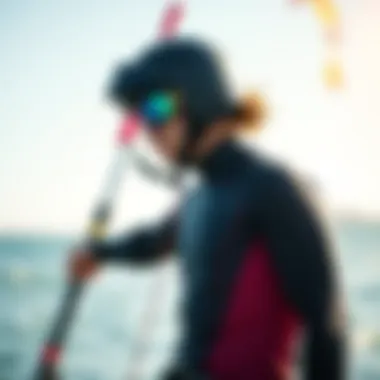
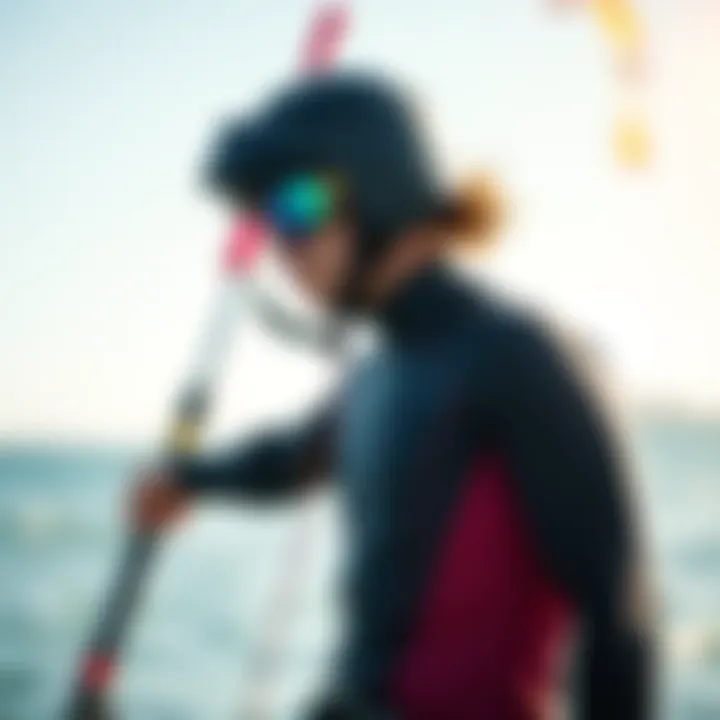
Another noteworthy variant is super-stretch neoprene. Infused with elastane, this material offers an incredible level of flexibility that caters perfectly to the dynamic movements involved in kiteboarding. With fewer restrictions on mobility, riders can perform tricks or navigate the water with ease, enhancing their overall experience.
In addition to performance, thickness matters. Generally, summer wetsuits are crafted from 2mm to 3mm neoprene, which offers just the right amount of insulation without overheating the wearer. This balance is essential for those hot summer days when you want to stay cool while still enjoying the benefits of a wetsuit.
"Choosing the right neoprene can mean the difference between a memorable day on the water and feeling weighed down."
Various brands have capitalized on neoprene customization, producing suits that feature specific panels made of lighter materials for better breathability. These tailored solutions are not just gimmicky; they directly impact the kiteboarder's performance by enhancing comfort, reducing fatigue, and increasing overall enjoyment.
Alternative Materials
While neoprene dominates the market, there’s a growing trend towards using alternative materials. Kiteboarders increasingly prioritize sustainability without sacrificing quality or durability. One such alternative is limestone-based neoprene, which is made from a natural resource as opposed to oil-based products. This substitution not only reduces the environmental footprint but also offers similar performance characteristics to traditional neoprene.
In addition to limestone neoprene, some manufacturers explore natural rubber sourced from rubber trees. This eco-friendly option provides a compelling option for the environmentally-conscious kiteboarder. Beyond being sustainable, natural rubber is known for exceptional elasticity and resilience, adding another layer of comfort to your ride.
Moreover, there are innovations like thermal-lined garments, often made of recycled materials. These suits may come with enhanced insulation capabilities while ensuring moisture-wicking properties, keeping discomfort at bay.
While considering these alternatives, it’s worth noting that guarantees of performance can vary. A good rider should seek feedback from fellow kiteboarders or peruse detailed reviews before committing to an alternative material suit.
In summary, understanding the materials used in summer wetsuits equips riders to make smarter decisions tailored to their needs, ensuring maximum fun and performance out on the water.
Design Considerations
When it comes to selecting a summer wetsuit, the design considerations are a key aspect that can significantly influence performance and comfort on the water. Kiteboarding requires not only mobility but also protection against the elements, and the right design ensures you stay comfortable even during the warmest days. This section will elaborate on specific design elements such as thickness and insulation, cut and fit, as well as seam construction—all vital in optimizing your wetsuit experience.
Thickness and Insulation
The thickness of a summer wetsuit typically ranges from 1.5mm to 3mm, depending on the conditions you expect to encounter. Choosing the right thickness is essential. Too thick, and you risk overheating; too thin, and you might feel chilly in cooler waters or winds. A 2mm suit is a popular choice for kiteboarders enjoying summer conditions, providing a balance of warmth and flexibility.
The insulation technology used in summer wetsuits has evolved. Many modern suits incorporate materials that offer increased buoyancy and warmth without adding bulk. For kiteboarders, this means greater freedom of movement and less fatigue while riding.
"Picking the right thickness can make or break your kiteboarding session. No one wants to wrestle with overheating or shivering!"
Cut and Fit
The cut and fit of a wetsuit are directly related to how well it performs in the water. Having a suit that fits snugly without being restrictive is crucial. An ideal fit allows for natural movement while effectively preventing water from entering.
Full Suit vs. Shorty
When discussing cut, one significant decision is between a full suit and a shorty wetsuit. A full suit covers the entire body, providing more warmth and protection, making it an excellent choice for those kiteboarding in slightly cooler conditions or during early summer.
On the other hand, a shorty—having short sleeves and legs—is favored for hotter weather. It offers increased freedom of movement, which can be appealing when kiteboarding. The benefit of a shorty is primarily comfort, especially when you're active and seeking to avoid excess water retention. The unique aspect of each style is how they cater to specific weather conditions and personal preferences.
Body Shape Considerations
Body shape plays a vital role in selecting the perfect wetsuit fit. Understanding your body's dimensions and how they relate to various wetsuit styles can greatly impact your performance.
Different brands often cater to specific body shapes, which means you’ll want to experiment with different suits to find the cut that suits you best. A tailored fit can reduce chafing and enhance insulation by forming an effective barrier against the water. This factor is particularly beneficial when you are spending hours in the water and want to feel your best throughout.
Seam Construction
Lastly, seam construction is an element not to be overlooked. The quality of seams can determine the durability of your wetsuit as well as its insulation properties. Properly constructed seams are essential as they prevent water entry while maintaining flexibility. Look for sealed seams or blind-stitched seams which are often found in higher-end options.
Investing in a wetsuit with superior seam construction can lead to longer-lasting wear and a far better experience on the water, particularly when conditions can change unexpectedly like sudden wind or a drop in temperature.
In summary, paying attention to these design considerations can greatly enhance your kiteboarding experience. With the right balance of thickness, fit, and seam quality, you'll ensure that you're well-prepared for whatever the waves throw your way.
Key Features of Summer Wetsuits
When it comes to kiteboarding, a well-designed summer wetsuit can make or break your experience. Understanding the key features of summer wetsuits is crucial for kiteboarders looking to enhance their performance and comfort on the water. These suits aren’t just about keeping you warm; they also provide a range of benefits that cater specifically to the needs of kiteboarders. Let’s dive into the details.
Zipper Types
In wetsuit design, the zipper type can greatly affect functionality and ease of use. Two common designs are the back zipper and the chest zipper. Each has its own merits and drawbacks, which can influence your choice depending on your style of riding and the conditions you face.
Back Zippers
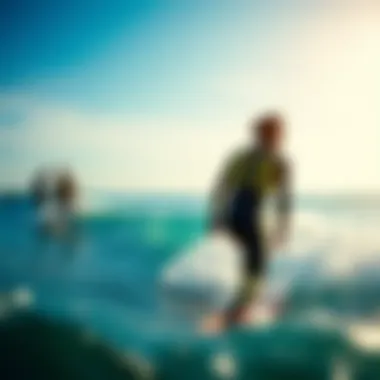
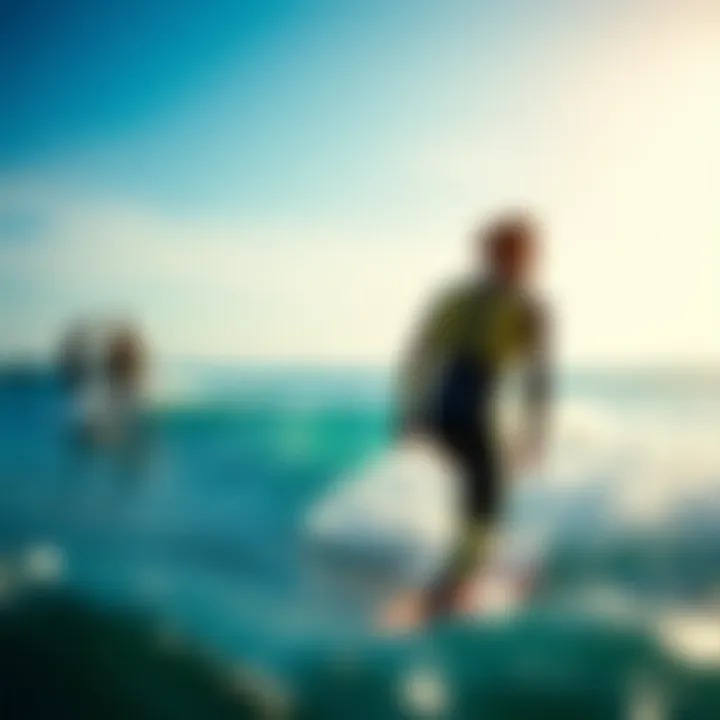
One of the most traditional designs in the wetsuit world is the back zipper. This type features a zipper that runs from the lower back up to the neck, making it simple to get in and out of the suit. A notable trait of back zippers is their ease of access, especially for quick changes or between sessions.
The unique feature of back zippers is their ability to provide greater flexibility in design and fit. However, they might not be as watertight as some other options, potentially letting in a bit of water if not secured properly. This can be a slight tradeoff since some kiteboarders may prioritize the ease of entry over a completely snug seal.
Chest Zippers
On the flip side, chest zippers have become increasingly popular among serious kiteboarders for several reasons. They run horizontally across the front of the wetsuit, which can provide a tighter seal against water penetration. This characteristic is particularly beneficial when you’re hitting those waves and being splashed with water.
A unique feature of chest zippers is the added comfort they offer. Because they limit water entry, your suit stays drier, improving your performance and overall warmth during longer sessions. However, the downside could be challenging entry and exit, which might frustrate some users, especially those who prefer something straightforward.
Paddle and Arm Design
The paddle and arm design of summer wetsuits plays a significant role in how effectively kiteboarders can maneuver their boards. Whether you are carving through waves or launching off the water, the fit of the arms can either hinder or enhance your experience.
Good paddle designs are tailored to provide a natural range of motion, ensuring that your arms don't feel restricted as you paddle or steer. Some suits incorporate specialized patterns or stretch panels in the underarms and shoulders. These features provide increased flexibility, allowing for more dynamic movements.
The arm design is not just about movement; it's also about comfort. Seam placements, for example, can significantly impact how the wetsuit feels during prolonged use. A well-constructed wetsuit will have seams designed to minimize chafing and abrasion during longer sessions.
Ultimately, choosing a wetsuit that features thoughtful paddle and arm design can enhance your kiteboarding journey, making each session more enjoyable and productive.
Choosing the Right Summer Wetsuit
Choosing the right summer wetsuit is not just about aesthetics or brand loyalty; it’s about ensuring you have the right gear to optimize your kiteboarding experience. Picking a wetsuit that aligns with your distinct needs can make a monumental difference between an enjoyable day on the water and one that leaves you clammy and uncomfortable.
When it comes to summer wetsuits, factors such as the cut, material, and additional features come into play. Each of these elements contributes to how well you can maneuver on the board while still protecting your body when in contact with sea water or potential falls.
In the context of kiteboarding, a summer wetsuit plays a dual role—it keeps you comfortable and safe, ensuring you can concentrate on your technique rather than being distracted by the elements. Not only do you want freedom of movement, but you also don’t want to overheat when the sun is high. Thus, understanding how to choose the right wetsuit isn’t just beneficial; it’s essential.
Identifying Your Needs
To determine which summer wetsuit is suitable for you, the first step is to identify your needs. What kind of kiteboarding activities do you frequently engage in? Are you riding in warm, tropical waters, or are you hitting cooler springs where the wind might bite? Think about what you do most and the environment you find yourself in; it will steer your decision.
- Water Temperature: If you’re in warm waters, a shorty wetsuit may keep you cool while providing some buffer against any unexpected tumbles or jellyfish stings.
- Riding Style: Freestyle kiters may require more flexibility in their arms and legs, evolving their choice to a thinner material that molds with their movements.
- Duration of Use: If you expect to spend long hours in the water, investing in a suit with a snug fit but breathable material is essential. You can’t compromise comfort when you find yourself sailing past the sunset.
Identifying these aspects helps narrow down the options significantly. Take notes on your priorities before you even step foot in a store or browse online, as this will focus your search.
Try Before You Buy
Before committing to any company or model, it is crucial to try before you buy. The reality is that sizing can vary dramatically between different brands. What fits you snugly in one may feel like a second skin in another, or conversely, it might be the complete opposite with an ill-fitting suit.
Here are some tips for evaluating fit:
- Move Around: When you try a wetsuit, make sure to paddle your arms and bend at the knees. You want to feel that it allows for free motion without pulling or pinching.
- Check the Seals: The neck, wrist, and ankle seals should be snug enough to keep water out, but not so tight that they cause discomfort.
- Stay Dry while Wet: Look for suits that feature a minimum of water entry while wearing. You want to emerge from the water with as little chill as possible.
"A wetsuit should feel like a second skin, providing support while letting you navigate the water easily."
In essence, trying on different models can save pain in the long run. Don’t settle for anything feel awkward or wrong—your time spent in the waves should be nothing less than enjoyable.
Choosing the right summer wetsuit isn't merely a task; it's a mission to enhance your kiteboarding adventures. Whether it's through identifying your specific needs or ensuring that the fit is just right, taking these considerations seriously will lead you to make an informed choice. By prioritizing comfort and performance, you ultimately elevate your experience on the water.
Maintenance and Care of Summer Wetsuits
Taking care of your summer wetsuit is crucial for those who regularly hit the waves, whether for kiteboarding or other water sports. Proper maintenance ensures that your wetsuit lasts longer and performs at its best. A well-cared-for wetsuit not only enhances your comfort but also helps maintain insulation properties, so you can focus on enjoying your time on the water without the nagging thought of wearing a worn-out suit. Let's break down some essential practices for keeping your wetsuit in tip-top shape.
Washing and Drying
The first step in maintaining your wetsuit involves washing it after every use. Saltwater and sand can be harsh on the fabric, not to mention the buildup of body oils and sunscreen that can cause degradation over time. Here’s a routine you might consider:
- Rinse Off: After your session, rinse your wetsuit inside and out with fresh, cold water. This removes salt and sand. Avoid hot water, as it might affect the neoprene's integrity.
- Gentle Wash: If you’ve really put it through its paces, a gentle wash with a wetsuit cleaner can be beneficial. Regular laundry detergents can damage the material, so stick to specially formulated wetsuit care products.
- Drying: Lay the wetsuit flat to dry in a shaded area, away from direct sunlight. Hanging it can lead to deformation in shape, while the sunlight can deteriorate the materials. Ensure the suit is turned inside out for the first half of the drying process to prevent color fading.
"Regular maintenance is not just about appearance; it’s about durability and performance too. A little attention goes a long way!"
Storage Recommendations
Where and how you store your wetsuit also plays a critical role in its lifespan. Here are some smart practices:


- Hang or Fold: If you can, use a wide hanger designed for wetsuits, since this minimizes creasing and stretching. If not able to hang, fold it neatly, ensuring it's not crammed in with other gear to avoid unnecessary pressure on the seams.
- Cool and Dark Location: Store your wetsuit in a cool, dark place. Heat and moisture can lead to mold and mildew, while prolonged exposure to sunlight can harm the material.
- Check for Pests: Occasionally, check your storage area for pests that might have an appetite for neoprene. A quick preventive measure might just save your favorite suit.
Following these washing and storage practices can significantly extend the life of your summer wetsuit and maintain its performance. Not only will this help in keeping your gear ready for those spontaneous kiteboarding adventures, but it also helps in preserving the investments you made in your equipment.
Trends in Summer Wetsuit Technology
As kiteboarding continues to grow, advancements in wetsuit technology become more pertinent. It’s not just about keeping warm; it’s about enhancing performance and comfort during warm weather. Understanding trends in summer wetsuit technology can lead to better choices that elevate your kiteboarding experience. With a breath of fresh air occasionally blowing across the water, innovative materials and designs are frequently finding their way into the market, reshaping how kiteboarders engage with the sport.
Eco-friendly Materials
The demand for sustainable options is on the rise. Kiteboarders today are better informed and more environmentally conscious than ever before. As such, many manufacturers are opting for eco-friendly materials. This isn't merely a trend, but a vital step for the community as a whole. Consider the growing use of natural rubber substitutes for neoprene. Brands have started incorporating materials like Yulex that come from renewable resources, providing not only a sustainable alternative but also maintaining flexibility and strength. Using these materials not only helps reduce pollution but also ensures that future generations can enjoy the same beautiful waters we do today.
Benefits of eco-friendly materials include:
- Lower Carbon Footprint: Materials such as Yulex use less energy in production compared to conventional neoprene.
- Biodegradable Options: Some newer materials can decompose, reducing waste in landfills.
- Performance: These materials often perform comparably to traditional options, ensuring you don’t have to sacrifice comfort for ethics.
Innovative Design Features
Continuous innovation defines the current landscape of summer wetsuits. Modern wetsuits are not just protective gear; they are increasingly seen as high-performance equipment. From special seams to enhance water flow to ergonomic cuts that provide mobility, these design features cater to the needs of kiteboarders.
Some noteworthy innovations include:
- Lighter Construction: This year’s summer wetsuits are even lighter than before, allowing for maximum mobility while maintaining necessary protection.
- Flex Zones: Brands are integrating flex zones that don’t constrict movement, vital when performing tricks or navigating waves.
- Improved Sealing Techniques: New sealing methods reduce water entry and keep the suit fitting snugly without feeling overly constricting.
Trends like these represent a fusion of practicality and performance—each improvement is aimed at making your time on the water more enjoyable. A well-designed wetsuit should feel like a second skin, allowing you to focus on riding rather than adjusting your gear.
The right wetsuit can turn a good kiteboarding session into a great one, making it worth the time to explore these current trends.
Keeping up with these trends not only keeps you ahead of the game but also contributes to the ethos of responsible kiteboarding. As the technology evolves, so does our approach to ensuring that the sport remains enjoyable, sustainable, and kind to the earth. With summer wetsuits moving in such innovative directions, it's an exciting time to hit the water.
Environmental Considerations
The environmental implications of summer wetsuits are becoming increasingly paramount as public awareness about sustainability grows. For kiteboarders, this extends beyond just personal performance; it directly touches on how our choices impact the broader ecosystem. Every time gear is purchased, it carries a consequence; hence, understanding these environmental considerations not only informs personal choices but also promotes a collective responsibility towards protecting our oceans and coastlines.
“The ocean stirs the heart, inspires the imagination, and brings eternal joy to the soul.” – Wyland
Sustainable Practices in Production
As demand for summer wetsuits rises, the industry has to address its environmental footprint. Sustainable practices in production focus primarily on materials and processes that minimize ecological harm.
- Material Sources: Eco-friendly wetsuits may be made from natural rubber or recycled materials. For instance, companies like Patagonia focus on sourcing materials that have a lower environmental impact, leading the charge in green innovations.
- Production Processes: It's not just about the raw materials; how wetsuits are manufactured matters too. Production techniques that reduce waste and energy consumption can significantly decrease their overall carbon footprint. Brands striving for sustainability often invest in cleaner technologies that limit harmful emissions during production.
- Packaging: Another component includes minimalistic and biodegradable packaging. A shift from plastic to recyclable materials can help in reducing landfill waste, thereby promoting more eco-friendly consumer habits.
By embracing these practices, kiteboarders can support brands that prioritize sustainable production, fostering a culture of ecological mindfulness while enjoying their sport.
Impact on Marine Life
The choices we make can leave marks not just on the land but deep beneath the waves. Kiteboarding and the gear used have direct effects on marine ecosystems.
- Chemical Run-off: Many traditional wetsuit manufacturing processes release toxic chemicals into waterways. This affects marine wildlife, coral reefs, and ecosystems that depend on clean water. Sustainable brands could make strides by adopting non-toxic materials, reducing harmful emissions tied to production.
- Microplastics: Some wetsuits shed microplastics with wear and tear, which eventually finds its way into the ocean. These microplastics disrupt food chains and can be ingested by sea life with devastating effects, causing imbalances in the ecosystem.
- Habitat Disruption: The production of conventional materials often involves processes that lead to habitat destruction, compromising not only marine flora and fauna but also the overall health of our oceans.
Being mindful of these factors can bolster not only individual kiteboarding experiences but also contribute to the preservation of marine environments.
As we ride the waves, the conversations about sustainability and environmental stewardship should ride alongside us, resonating just as strongly. It is the responsibility of the kiteboarding community to ensure that while we seek the thrill of the sport, we are equally committed to protecting the waters we enjoy. For further reading on environmental impacts specific to ocean sports, visit National Oceanic and Atmospheric Administration, and for a deeper dive into marine conservation, check out Marine Conservation Society.
Ending
In the world of kiteboarding, having the right summer wetsuit is akin to having the right gear in any sport; it can make or break your experience on the water. A well-chosen wetsuit not only keeps you comfortable but also enhances your performance. The nuances of fit, material, and design all play a significant role in dictating how active and free you feel while riding the waves. Furthermore, understanding how to care for your wetsuit will ensure it lasts longer, providing you with reliability during your summer kiteboarding sessions.
Summarizing Key Points
To recap, several essential elements come into play when selecting the perfect summer wetsuit for kiteboarding:
- Material Matters: The choice between different neoperene variants and alternative materials can greatly affect not just comfort, but also warmth and flexibility.
- Design for Performance: The thickness, cut, and seam construction of the wetsuit need to match your specific activity level and personal preferences. Whether you opt for a full suit or a shorty, the fit should be snug but not restrictive.
- Care is Crucial: Washing and drying your wetsuit properly contributes to its longevity, reducing wear and tear from sun exposure and salt water.
- Trends and Sustainability: Keeping an eye on eco-friendly materials and innovative features will not only benefit you but also contribute positively to environmental efforts.
Future Insights on Wetsuit Technologies
Looking ahead, the landscape for wetsuit technology seems poised for remarkable advancements. With ongoing research and development, the focus on sustainability raises the bar concerning material production, including the use of recycled plastics and natural resources. This shift not only benefits the environment but also caters to an increasingly eco-conscious customer base.
New design innovations are likely to emerge, such as enhanced thermal protection that incorporates lightweight materials designed to keep body temperature regulated without bulk. Anti-chafing technology combined with wear-resistant zones can also be expected, adding another layer of comfort and performance.
The future also looks promising with regard to wearable technology integration, potentially allowing for real-time monitoring of body temperature and hydration, ultimately enhancing the safety and experience for kiteboarding enthusiasts.
In summary, the journey through summer wetsuits has unveiled a multitude of considerations that can elevate kiteboarding experiences. Whether you're a seasoned pro or a beginner venturing into these warm-weather waters, keeping these insights in mind will equip you for success on the board.















